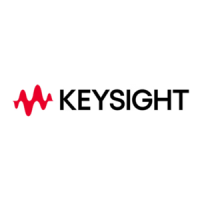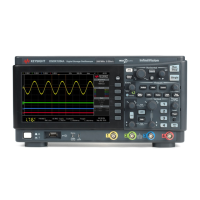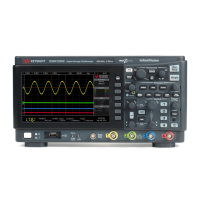Do you have a question about the Keysight DSOX3012T and is the answer not in the manual?
| Brand | Keysight |
|---|---|
| Model | DSOX3012T |
| Category | Test Equipment |
| Language | English |
Connecting oscilloscope probes to BNC connectors and the test point.
Matching probe's input capacitance to channel for accurate measurements.
Adjusting the time base setting using the horizontal scale knob.
Moving the trigger point horizontally using the delay (position) knob.
Setting the vertical sensitivity (volts/division) using the large knob.
Moving the waveform up or down on the display using the small knob.
Resizing and repositioning the math waveform using multiplexed knobs.
Resizing and repositioning math waveforms using multiplexed knobs.
Connecting digital probe cables to the device under test and ensuring proper ground.
Updating display with new acquisitions without immediately erasing previous ones.
Adjusting the vertical level for analog channel edge detection using the Trigger Level knob.
Identifying triggers by specified edge (slope) and voltage level on a waveform.
Triggering on a positive or negative pulse of a specified width.
Identifying trigger conditions by looking for a specified pattern across channels.
Triggering on a rising or falling transition between levels within a certain time.
Triggering on any selected line of a video signal for complex waveform analysis.
Selecting between Auto trigger mode (default) or Normal trigger mode.
Selecting DC, AC, LF Reject, or Video coupling for the trigger path.
Using [Run/Stop] and [Single] keys to start, stop, and capture single acquisitions.
Choosing acquisition modes like Normal, Peak Detect, Averaging, or High Resolution.
Connecting signals and using cursors to make custom voltage, time, phase, or ratio measurements.
Displaying the Measurement Menu and adding automatic measurements.
Understanding voltage measurement points like Peak-Peak, Maximum, Minimum, Amplitude, and Top.
Measuring time-related parameters such as Period, Frequency, Rise Time, and Fall Time.
Configuring the oscilloscope to display a golden waveform and enabling mask testing.
Specifying conditions to terminate mask testing, such as number of tests or time.
Using the DVM feature for 3-digit voltage measurements on analog channels.
Using the integrated hardware counter for frequency, period, or edge event measurements.
Configuring sweep frequencies, channels, and generator amplitude for analysis.
Accessing the Waveform Generator Menu and selecting waveform types and parameters.
Defining the shape of arbitrary waveforms using the Edit Waveform Menu.
Saving oscilloscope setups, screen images, and waveform data to internal memory or USB.
Accessing and configuring remote control interfaces like USB and LAN.
Placing the oscilloscope on the network and setting up its LAN connection.
Assigning common, repetitive actions to a single key press.
Connecting to the oscilloscope via LAN and accessing its web server.
Accessing full scope, screen only, or tablet remote front panels and SCPI commands.
Connecting to CAN signals and specifying source, threshold, baud rate, and sample point.
Setting up triggers for CAN version 2.0A, 2.0B, and CAN FD signals.
Setting up CAN serial decode for capturing and displaying CAN FD frames.
Connecting to LIN signals and specifying source, threshold, baud rate, and sample point.
Triggering on LIN signals based on Sync Break, Frame ID, or Frame ID and Data.
Setting up LIN serial decode for capturing and displaying LIN signals.
Connecting to CXPI signals and specifying source, threshold, baud rate, and tolerance.
Setting up triggers on CXPI frames, errors, or events.
Setting up CXPI serial decode for capturing and displaying CXPI signals.
Connecting to FlexRay signals and specifying source, threshold, baud rate, and bus type.
Setting up triggers on FlexRay frames, errors, or events.
Setting up FlexRay serial decode for capturing and displaying FlexRay signals.
Connecting to I2C signals and specifying source, threshold voltage levels.
Triggering on I2C stop/start conditions, restarts, missing acknowledges, or EEPROM data reads.
Setting up I2C serial decode for capturing and displaying I2C signals.
Connecting to SPI signals and specifying clock, MOSI, MISO, and framing signals.
Triggering on SPI data patterns at the start of a frame.
Setting up SPI serial decode for capturing and displaying SPI signals.
Connecting to I2S signals and specifying clock, word select, and serial data lines.
Triggering on I2S signals based on data value.
Setting up I2S serial decode for capturing and displaying I2S signals.
Connecting to Manchester signals and specifying signal, bus configuration, and settings.
Setting up Manchester triggers based on start of frame, value, or Manchester error.
Setting up Manchester serial decode for capturing and displaying Manchester signals.
Connecting to NRZ signals and specifying signal, bus configuration, and settings.
Setting up NRZ triggers based on start of frame or value.
Setting up NRZ serial decode for capturing and displaying NRZ signals.











